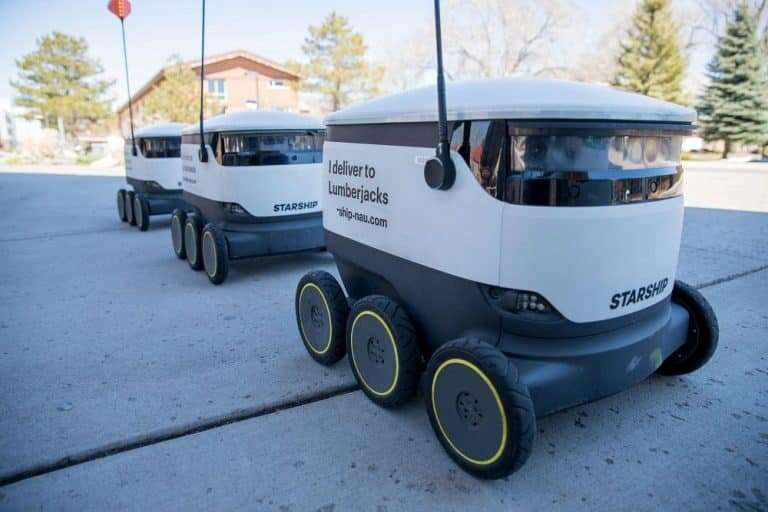This article has been reviewed according to Science X's editorial process and policies. Editors have highlighted the following attributes while ensuring the content's credibility:
fact-checked
trusted source
proofread
Got robot delivery? New research demonstrates need for robot-friendly infrastructure

Spend five minutes on a college campus and you'll see walkers, runners, cyclists, skateboarders, a dog or two and maybe somebody on a hoverboard. Increasingly these days, you'll also find six-wheeled robots offering contactless food delivery.
And just like with all users of busy multi-use sidewalks, those robots add the potential of collisions and dangerous interactions with others on the same walkway. A new study from Northern Arizona University examines the frequency of these conflicts and what causes them with the goal of fixing issues in the future.
Steven Gehrke, an assistant professor in the Department of Geography, Planning and Recreation (GPR); Christopher Phair, a master's student in applied geospatial sciences; Brendan Russo, an associate professor in the Department of Civil Engineering, Construction Management, and Environmental Engineering (CECMEE); and Edward Smaglik, a CECMEE professor, co-authored the article, published in Transportation Research Interdisciplinary Perspectives in March.
Lead author Gehrke said the research, which is the first of its kind to examine how sidewalk autonomous delivery robots (SADRs) impact pedestrian and bicyclist safety, highlighted a need for more deliberate decision-making regarding the routing of these robots around college campuses. Informed future planning decisions as well as evolving facility management practices are critical to allow the robots and pedestrians to safely move throughout the same spaces.
"With the continued emergence of these delivery services on college campuses, which have expansive sidewalk networks and a technological-savvy consumer market, we believe this work can help inform other campuses who have recently or are considering an introduction of these services to ensure their safe operation in shared-use environments," he said.
What the research says
The researchers made their observation on NAU's campus, which has had SADRs since 2019. They set up cameras at 10 sites and then observed interactions over a one-week period and identified human-robot conflicts, determining whether the person or the robot entered the conflict zone first and what evasive action was taken. They also classified each interaction as moderate, dangerous or not a conflict. An interaction was considered dangerous if the traveler and robot crossed a shared point of the pathway before 1.5 seconds elapsed. They recorded 12 instances when the elapsed time was zero seconds, which means a collision occurred.
They found that in the more serious conflicts, most occurred when an SADR was crossing in front of or overtaking a pedestrian on a sidewalk.
The researchers also observed other characteristics of the sites that could impact travel—sidewalk width, the number of intersections and the number of robots, pedestrians and cyclists in the area—and found that sites with narrower sidewalks and more intersections had more dangerous interactions.
This research points to the need for SADR routes that prioritize parallel travel of the robots along wide sidewalks and minimizing high-activity sidewalk crossings. Having the robots drop off their food orders at less-trafficked, well-marked sites also should help reduce interactions.
This is especially important for cities that are considering using SADRs, especially as cities are focused on promoting the safety of more sustainable modes of travel. They may need new infrastructure along with education and route programming for the robots to reduce as much of the potential for conflict as possible.
"Research on the real-world introduction of this technology on facilities shared with pedestrians and cyclists is important for providing practitioners the evidence they need to support programs and policies that ensure the safe operations of these devices in environments with vulnerable roadway users," Gehrke said, adding that more research is needed. "One particular area where we have received interest is in helping cities determine what is the right fleet size to meet their delivery needs without compromising the ability of pedestrians and cyclists to safely traverse their downtown street network."
More information: Steven R. Gehrke et al, Observed sidewalk autonomous delivery robot interactions with pedestrians and bicyclists, Transportation Research Interdisciplinary Perspectives (2023). DOI: 10.1016/j.trip.2023.100789




















